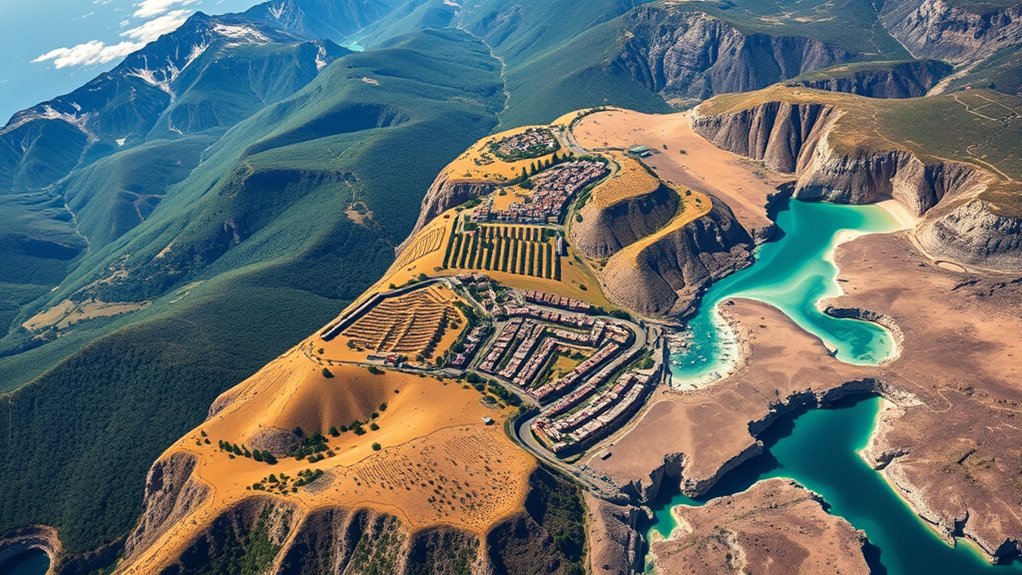Italy’s climate varies greatly across regions, so plan your trip accordingly. In the north, expect cold winters with snow—perfect for winter sports—and cool summers. Central Italy has mild winters and warm, wet summers, while the south offers hot, dry summers and mild winters. Coastal areas tend to have milder weather year-round. Understanding these climate zones helps you choose the best time to visit each region, and if you keep exploring, you’ll discover how to tailor your plans for every season.
Key Takeaways
- Northern Italy has a temperate climate with cold winters and warm summers, ideal for winter sports and summer sightseeing.
- Central Italy features a Mediterranean climate with mild, wet winters and hot, dry summers suitable for outdoor activities year-round.
- Southern Italy experiences hot, dry summers and mild winters, making it perfect for beach destinations and outdoor exploration.
- Regional topography influences weather patterns, with the Alps offering snowy winters and coastal areas providing milder conditions.
- Seasonal weather varies across regions, so plan activities and packing based on local climate conditions for optimal comfort and experience.

Ever wondered why Italy’s weather varies so much across the country? The answer lies in its diverse climate classification and the distinct regional weather patterns that define each area. Italy’s geography, stretching from the Alps in the north to the Mediterranean in the south, creates a complex climate landscape. You’ll find that the northern regions experience a temperate climate with cold winters and warm summers, while the central areas enjoy a more Mediterranean climate with mild, wet winters and hot, dry summers. Moving further south, the climate shifts to a typically Mediterranean one, characterized by hot, dry summers and mild winters, perfect for planning your trip around the seasons.
Understanding the climate classification helps you anticipate what weather to expect in different parts of Italy. For example, the alpine zone, with its high elevation, sees long, snowy winters ideal for winter sports enthusiasts. Meanwhile, the coastal regions benefit from milder conditions year-round, making them suitable for beach vacations even outside peak summer months. The regional weather patterns, driven by Italy’s varied topography, influence everything from rainfall to temperature fluctuations. The north’s proximity to the Alps means it receives more precipitation, often in the form of snow during winter, while the south tends to be drier, especially in summer.
If you’re planning a trip in spring or fall, knowing these regional weather patterns can help you choose the best destinations. In the north, expect cooler temperatures and the possibility of rain, so packing layers and waterproof gear is wise. Conversely, the south will generally offer warmer weather and sunnier skies, ideal for exploring outdoor sights or enjoying coastal towns. Summer, however, can be scorching in the south, so if you prefer milder conditions, heading north or to higher elevations might make your trip more comfortable.
In winter, the climate classification indicates that the north can be quite cold, with snow transforming the Alps into a winter wonderland, perfect for skiing. The central regions experience milder winters, while the south remains relatively warm, often with only brief cold spells. This variation in regional weather patterns means you should tailor your packing and activities according to where you’re headed. Whether you’re seeking winter sports, beach relaxation, or cultural exploration, understanding Italy’s diverse climate zones ensures you’re prepared for the weather you’ll encounter. Additionally, regional climate zones influence local traditions and agricultural practices, enriching your travel experience.
Frequently Asked Questions
How Do Italian Climate Zones Vary Year-To-Year?
You’ll notice Italian climate zones vary year-to-year due to climate variability, causing unpredictable seasonal fluctuations. Some years, winters may be milder or wetter, while summers could be hotter or drier. This variability affects your travel plans, so it’s wise to monitor weather forecasts and seasonal trends before your trip. By staying flexible, you can enjoy Italy’s diverse climate and adapt to changing conditions, making your visit enjoyable regardless of annual fluctuations.
Are There Regional Differences Within Each Climate Zone?
Yes, there are regional differences within each climate zone. You’ll notice regional microclimates and local weather patterns that influence temperature, rainfall, and seasonal conditions. For example, coastal areas tend to be milder and more humid, while inland or mountainous regions experience more extreme temperatures and varied weather. When planning your trip, consider these microclimates to better anticipate local weather and enjoy a more tailored experience.
What Are the Best Months for Outdoor Activities in Each Zone?
Think of Italy’s climate zones as different chapters in a story—each with its own best outdoor months. For the Mediterranean chapter, spring and fall are ideal, bursting with mild weather for hiking and sightseeing. In the Alpine chapter, summer and early fall offer the best outdoor months for mountain adventures. Use this seasonal activity planning to choose your timing and enjoy Italy’s diverse landscapes at their peak.
How Do Climate Zones Affect Italian Local Festivals?
You’ll notice climate zones greatly influence Italian local festival timings and cultural event variations. In warmer southern regions, festivals often occur in summer, celebrating local traditions outdoors. In contrast, northern areas host events mainly in spring or autumn to avoid harsh winters. Climate conditions guide these timings, ensuring you experience authentic celebrations at their best. Adjust your travel plans accordingly to enjoy festivals when the weather aligns with local customs.
What Are Common Weather-Related Travel Disruptions in Italy?
You might face weather-related travel disruptions like heavy rain, snow, or fog in Italy, especially during winter and spring. These conditions can delay or cancel flights and trains. To stay prepared, pack seasonal clothing suitable for sudden weather changes and consider travel insurance to cover unexpected delays or cancellations. Staying flexible with your plans helps you enjoy your trip despite the weather surprises.
Conclusion
As you plan your trip through Italy’s diverse climate zones, you’ll find that the weather often surprises you—sometimes warm in unexpected mountain towns or chilly along the coast. It’s almost like the country’s climate has a personality of its own, guiding your adventures in ways you didn’t anticipate. So, stay flexible, pack smart, and embrace the delightful coincidences. After all, Italy’s unpredictable weather just adds to the charm of your unforgettable journey.









